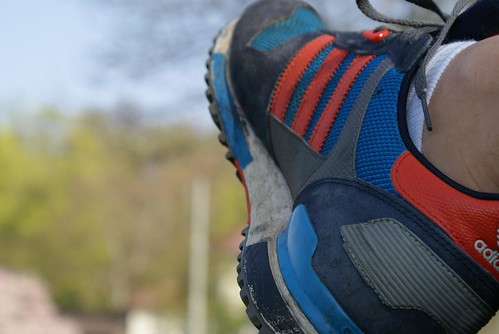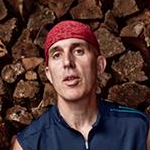
From the UK DailyMail comes an article titled The painful truth about trainers: Are running shoes a waste of money? (link) by Christopher McDougall. It’s a lengthy and thorough write-up about the history of “trainers,” or athletic shoes (sneakers or tennis shoes) for us across the pond. The article also details the three following “painful truths” about sneakers:
- That the more expensive your sneakers, the more prone you are to injury. This conclusion is drawn from a study of 4000+ runners, “Runners in shoes that cost more than $95 were more than twice as likely to get hurt as runners in shoes that cost less than $40.”
- Feet need the feedback the ground provides and padded soles interfere with this feedback. A conclusion drawn from a study on gymnasts: “They found that the thicker the landing mat, the harder the gymnasts landed. Instinctively, the gymnasts were searching for stability. When they sensed a soft surface underfoot, they slapped down hard to ensure balance. Runners do the same thing.”
- Just as when running (or walking) barefoot results in pronation (landing on the outside edge of the balls of your feet and rolling outside in, from little to big toe) and allows for foot arch compression and shock absorption, padding and arch support in sneakers encourage heel-striking and dampen the arch support and elasticity of our feet. In other words, mother nature/evolution/whatever gave us barefeet, and interfering with this bit of biological engineering by wearing sneakers causes problems.
McDougall ultimately suggests that we all may be better off barefoot (or as close to barefoot as possible). Surprised? I didn’t think so. This site is all about living life as mother nature intended — i.e. while wearing your birthday shoes (or as close to that state as possible)!
Unfortunately, the article fails to mention the most minimalist, yet dynamic (i.e. not flipflops, which are pretty minimalist, but not dynamic!) footwear currently available to runners (or anyone!); I’m referring, of course, to the beloved and quirky Vibram Five Fingers.
I’ll return to this omission in a minute.
On the Origins of Sneakers (and Nike)
McDougall makes mention of the formation of Nike, which is really the business that made extra padding, air cushions, and all sorts of high-tech shoe gadgetry mainstream. What is particularly interesting about the Nike formation anecdote is the bit about Nike’s co-founder Bill Bowerman (the other guy was Phil Knight). Please read the following blockquote, which talks how Bowerman got into running via his mentor Arthur Lydiard (bolding mine):
Bowerman didn’t actually do much running. He only started to jog a little at the age of 50, after spending time in New Zealand with Arthur Lydiard, the father of fitness running and the most influential distance-running coach of all time. Bowerman came home a convert, and in 1966 wrote a best-selling book whose title introduced a new word and obsession to the fitness-aware public: Jogging.
In between writing and coaching, Bowerman came up with the idea of sticking a hunk of rubber under the heel of his pumps. It was, he said, to stop the feet tiring and give them an edge. With the heel raised, he reasoned, gravity would push them forward ahead of the next man. Bowerman called Nike’s first shoe the Cortez – after the conquistador who plundered the New World for gold and unleashed a horrific smallpox epidemic.
It is an irony not wasted on his detractors. In essence, he had created a market for a product and then created the product itself.
‘It’s genius, the kind of stuff they study in business schools,’ one commentator said.
Bowerman’s partner, Knight, set up a manufacturing deal in Japan and was soon selling shoes faster than they could come off the assembly line.
…
So, if running shoes don’t make you go faster and don’t stop you from getting hurt, then what, exactly, are you paying for? What are the benefits of all those microchips, thrust enhancers, air cushions, torsion devices and roll bars?
The answer is still a mystery. And for Bowerman’s old mentor, Arthur Lydiard, it all makes sense.
‘We used to run in canvas shoes,’ he said.
‘We didn’t get plantar fasciitis (pain under the heel); we didn’t pronate or supinate (land on the edge of the foot); we might have lost a bit of skin from the rough canvas when we were running marathons, but generally we didn’t have foot problems.
‘Paying several hundred dollars for the latest in hi-tech running shoes is no guarantee you’ll avoid any of these injuries and can even guarantee that you will suffer from them in one form or another. Shoes that let your foot function like you’re barefoot – they’re the shoes for me.’
How bizarre is it that Bowerman, inspired by Lydiard to get into jogging, had an idea that ultimately begot an empire of fancy, overpriced and overpadded “athletic” shoes, shoes that Lydiard writes off today as completely unnecessary? I can only guess that Lydiard didn’t tell Bowerman about the goodness of barefooted running and minimalist footwear back in the early 70s when they met (prior to Nike’s creation).
On Nike Free
Another bizarre aspect of this article is that it effectively condemns the sneaker/trainer industry as being a marketing charade that encourages people to buy expensive shoes that do them no good and may actually cause them harm; it puts Nike at the center of this circus of fault; and then provides Nike with a platform to promote it’s “barefoot running shoes,” the Nike Free.
The marketing literature for Nike Frees clearly rely on the “barefoot is good” meme. However, Nike Frees are still shoes with padded soles as you can see from any of these Google Image Search results for the “advanced” (i.e. most barefoot-like) Nike Free 3.0.
The gaping chasm between Nike Free’s and actual bare feet is perhaps best depicted via the “Nike Free Range” flash graphic on their website: See it here, click on “The Evolution”. On on one side is the traditional sneaker and on the other is a barefoot. Saddled between these two extremes are the three versions of Nike Free shoes, which range from the 7.0 providing “Everyday support,” the Nike Free 5.0 providing “Medium support”, and the Free 3.0 which provides “Minimal support.” In my opinion everything by the barefoot, which would provide “No support,” is an evolution fail, but you can’t sell bare feet right? (Well unless you have invented a rubber soled “foot glove,” I suppose)
Conclusion
My write-up on the lengthy DailyMail article has gotten a bit lengthy, itself. Sorry. In short, I am happy to see increased awareness about how fancy sneakers are messing up our feet and that we may be a lot better off doing things in our birthday shoes. I’m disappointed the article fails to mention Five Fingers while providing a pitch for the still-sneakers, Nike Free. I’ll just have to be satisfied with baby steps towards increased awareness that our feet were meant to be unshod, and if you don’t want to risk the concrete-ified and trashed areas you trod donning your birthday shoes in full glory, at least you can get 95% there with Five Fingers.

Be sure and check out my interview with Christopher McDougall!
In it, Chris talks about denying your nature, the sports shoe industry, getting to barefoot, cross-pollinating ideas, and more!

5 replies on “The Painful Truth about [Sneakers]”
From the intro para, it appears that it isn’t so much an article as a large excerpt from a new, unnamed, book by Christopher McDougall. That doesn’t detract from the message but might result in some interesting reading when the book is released. A quick search on Amazon shows that it’s probably from his book “Born to Run: A Hidden Tribe, Superathletes, and the Greatest Race the World Has Never Seen” to be released in early May.
Interesting information about running shoes. Thanks for it!!
yes. the passage is definitely from McDougal’s book “Born to Run”. Just finished reading it. Great book.
Funny though- reading the book didn’t instantly make my hip pain go away. However, got out an old pair of running shoes that have much less support, and am working on changing my running style. Less heal strike, more mid-foot and toe. Seems to feel better so far.
Five Fingers may be in my future- but I’ll need to work up to them.
I bought and sadly had to return the Vibram Five Fingers Sport today: Reason, I have Greek feet. (Middle toe is longer than the big toe.
If your gonna make a shoe that mimics a foot, you should at least provide a model with a longer middle toe. Maybe Vibram can do a Five Finger custom where they send you a mold and you send it back and they custom make your shoes. I would pay 30 to 40% more for them. Right now, my foot conforms to the fingers and my middle toe gets crunched. I did measure to the length of my middle toe as suggested on their site.
So I’ve ordered the Nike Free 5. Can’t find a 3 on the Nike store. I’m thinking I should just get some water shoes and run in them.
Anybody have a suggestion for alternative barefoot coverings?
Gary depending how long your second toe is there is a mod to take care of that longer toe issue